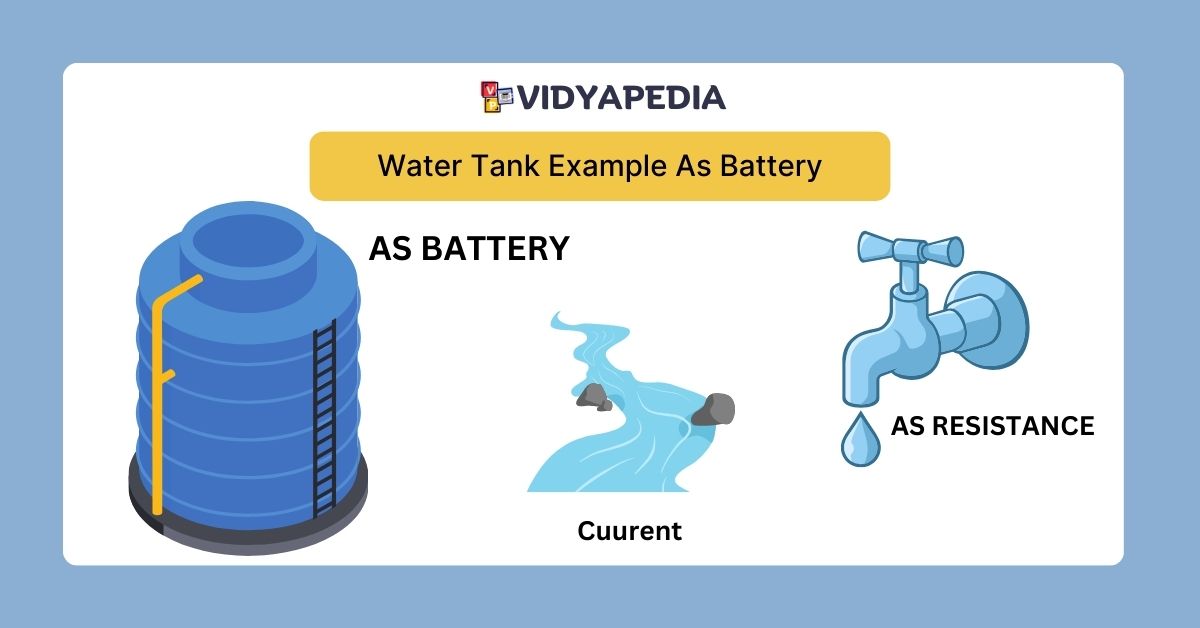When two or more cells are combined, they form a battery. Cells can be connected in series or parallel configurations to form a battery, and the resulting output will be in the form of current.
Current Flow
A cell or battery always contains electrons and positive charges. The flow of electrons and positive charges is called current. When we consider the flow of electrons, the current flows in the direction opposite to the electrons (conventional current direction). If we take reference to the flow of holes (positive charges), the current flows in the same direction as the positive charges.
Voltage
The voltage of a battery is the potential difference between its two terminals. For example, if a battery has a voltage of 3 volts, it means there is a 3-volt difference between the positive and negative terminals. The potential at each terminal can be different, but the difference between them defines the voltage of the battery.
Power
The power of a battery can be defined as the product of the voltage and the current it supplies. For instance, if a 3-volt battery supplies a current of 3 amps, the power is given by
\mathbf{P}=\mathbf{V} \times \mathbf{I}3 \mathrm{~V} \times 3 \mathrm{~A}=9 \mathrm{~W} The power output can vary depending on the circuit it is connected to. The capacity of a battery to deliver this output is also a measure of its power. Essentially, the power is determined by how much current the battery can deliver given its voltage.
Energy
The energy delivered by a battery is calculated by multiplying the voltage, current, and the time for which it supplies the current. For example, if a 3-volt battery supplies a current of 0.1 amps for 20 seconds, the energy is
E=V \times I \times t \text {, which equals to }E= 3 V \times 0.1 \mathrm{~A} \times 20 \mathrm{~s}=6 J \text { (Joules). }Resistance
Resistance is the property of a material that opposes the flow of electric current. A device specifically designed to offer resistance is called a resistor. If the current in a circuit is lower than expected, it indicates that the circuit has some resistance. All materials have some inherent resistance, including the internal resistance within batteries. There is no ideal material with zero resistance in real-world applications.
Components Of Electronic Level And Their Functions
Water Tank Example To Understand Battery I, V, P and E
Battery as a Water Tank:
- Think of a water tank as battery.
- The water inside the tank represents electrons, or electric charges.
- The size of the tank (how much water it can hold) is like the battery’s voltage.
Water Flow as Electric Current:
- The flow of water from the tank through a pipe represents electric current.
- Just like water flows from a full tank to an empty space, electric current flows from a higher voltage to a lower voltage.
Water pressure as voltage
- The pressure pushing water out of the tank is like voltage.
- Higher water pressure means more force pushing the water, just like higher voltage means more electrical force pushing electrons.
Flow Rate of Water as Current:
- The rate at which water flows out of the tank represents the electric current.
- If more water flows out per second, the current is higher. Similarly, a higher electric current means more charge is flowing per second.
Power as Tank Capacity:
- The power of the battery can be thought of as how much water the tank can push out at a certain pressure.
- In electricity, power is the product of voltage (pressure) and current (flow rate).
- For example, if the water pressure is 3 units and the flow rate is 3 units per second, the power is 3×3=93 \times 3 = 93×3=9 units.
Energy as Water Delivered Over Time:
- Energy is like the total amount of water that flows out of the tank over a period of time.
- If the tank delivers water at a rate of 0.1 units per second for 20 seconds, the total energy is 3×0.1×20=63 \times 0.1 \times 20 = 63×0.1×20=6 units of water.
Resistance as Flow Opposition:
- Resistance can be thought of as something that restricts water flow, like a narrow pipe or a partially closed valve.
- This restriction limits the flow of water, just like resistance limits the flow of electric current.
- All pipes have some resistance, and similarly, all materials have some electrical resistance.
- There’s no perfect pipe with zero resistance, just like there’s no material with zero electrical resistance in real life.


